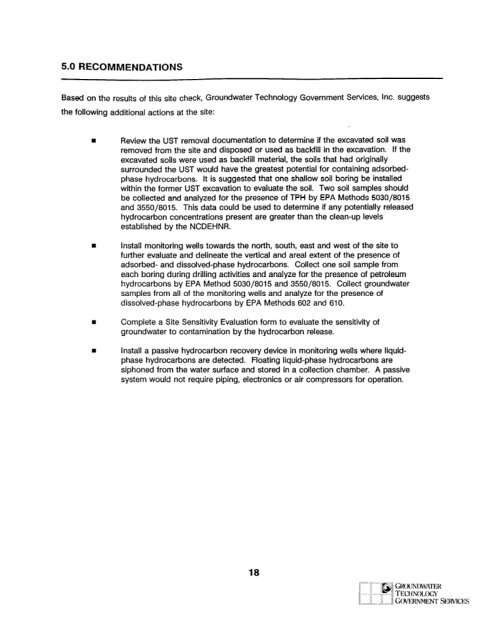three well site check bldg lch-4022
three well site check bldg lch-4022
three well site check bldg lch-4022
Create successful ePaper yourself
Turn your PDF publications into a flip-book with our unique Google optimized e-Paper software.
5.0 RECOMMENDATIONSBased on the results of this <strong>site</strong> <strong>check</strong>, Groundwater Technology Government Services, Inc. suggeststhe following additional actions at the <strong>site</strong>:w Review the UST removal documentation to determine if the excavated soil wasremoved from the <strong>site</strong> and disposed or used as backfill in the excavation. If theexcavated soils were used as backfill material, the soils that had originallysurrounded the UST would have the greatest potential for containing adsorbedphasehydrocarbons. It is suggested that one shallow soil boring be installedwithin the former UST excavation to evaluate the soil. Two soil samples shouldbe collected and analyzed for the presence of TPH by EPA Methods 5030/8015and 3550/8015. This data could be used to determine if any potentially releasedhydrocarbon concentrations present are greater than the clean-up levelsestablished by the NCDEHNR.n Install monitoring <strong>well</strong>s towards the north, south, east and west of the <strong>site</strong> tofurther evaluate and delineate the vertical and areal extent of the presence ofadsorbed- and dissolved-phase hydrocarbons. Collect one soil sample fromeach boring during drilling activities and analyze for the presence of petroleumhydrocarbons by EPA Method 5030/8015 and 3550/8015. Collect groundwatersamples from all of the monitoring <strong>well</strong>s and analyze for the presence ofdissolved-phase hydrocarbons by EPA Methods 602 and 610.n Complete a Site Sensitivity Evaluation form to evaluate the sensitivity ofgroundwater to contamination by the hydrocarbon release.n Install a passive hydrocarbon recovery device in monitoring <strong>well</strong>s where liquidphasehydrocarbons are detected. Floating liquid-phase hydrocarbons aresiphoned from the water surface and stored in a collection chamber. A passivesystem would not require piping, electronics or air compressors for operation.18
















